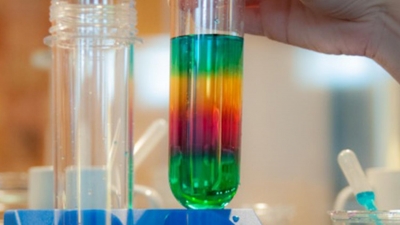
What you need:
- Vegetable oil
- Corn syrup (if you don’t have this, you can also use honey)
- Water
- Baking soda
- Food colouring
- Vinegar
- Dropper
- Small cups
- One large glass
What to do:
1. In a glass, pour corn syrup up to a depth of 1 inch (roughly 2.5 cm). Add a couple of drops of red food colouring and mix well.
2. Sprinkle 1/4 inch (i.e. about 0.75 cm) of baking soda over the coloured corn syrup. Do not mix.
3. Gently pour down water using the walls of the glass. The depth should be 1 inch (2.5 cm).
4. Next, add vegetable oil; its layer should also measure 1 inch (2.5 cm).
5. In a separate cup, pour some vinegar. Add a few drops of blue food colouring to dye it. This will help you differentiate it better from the other liquids.
6. Pick up some of this coloured vinegar in the dropper. Then add it to the glass. Keep adding it and watch what happens.
7. Next, fill the dropper with vinegar once again and push its tip right upto the baking soda layer. Squeeze out the vinegar here. Add more if needed.
What happens:
Firstly, all the liquids remain in their separate layers. When you drop in the vinegar, it falls through the oil but cannot make it to the layer of water.
When you add vinegar to the baking soda, you see bubbling and foaming.
Why?
What you’ve created here is a density tower i.e. a tower comprised of liquids of different densities. Density is nothing but how close the molecules of a substance are packed together. If the space between the molecules is less, we say that the substance is dense.
In order to be able to float over a liquid, the density of a substance (or of another liquid, in this case) needs to be lower than that of the liquid. Here, corn syrup (or honey) is the densest of the lot so it rests at the bottom. Water is heavier or denser than oil but less dense than corn syrup, so it makes the middle layer and oil stays at the top.
Vinegar is mostly made up of water which means it is denser than oil. So it falls through the layer of oil, trying to get down. But it doesn’t quite make it and gets beaded up and suspended in the layer of oil (since the two liquids don’t mix). And lastly, when you add the vinegar to the layer of baking soda, a chemical reaction occurs that releases carbon dioxide. This gas is what you see as bubbles.
Picture Credit : Google




